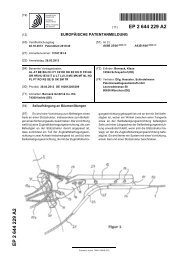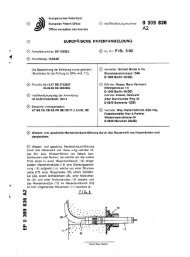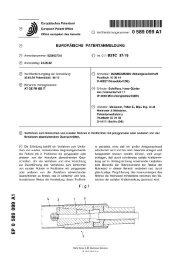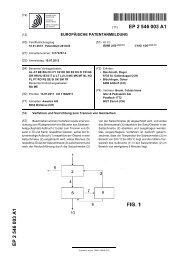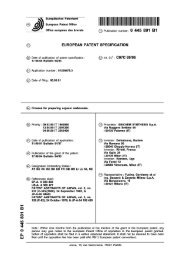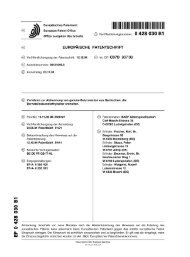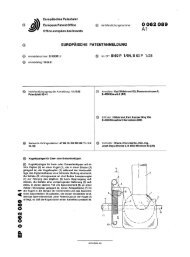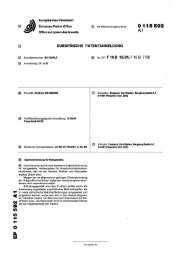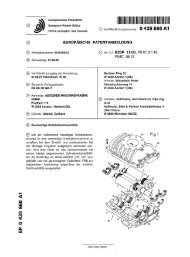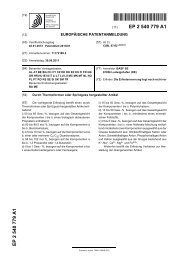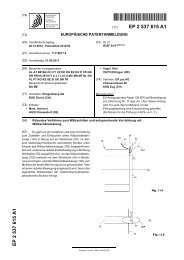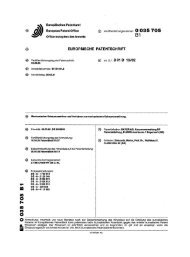EP 1917072 B1 - Patent data - European Patent Office
EP 1917072 B1 - Patent data - European Patent Office
EP 1917072 B1 - Patent data - European Patent Office
You also want an ePaper? Increase the reach of your titles
YUMPU automatically turns print PDFs into web optimized ePapers that Google loves.
(19)T<strong>EP</strong>ZZ_9_7Z7 B_T(11) <strong>EP</strong> 1 917 072 <strong>B1</strong>(12) EUROPEAN PATENT SPECIFICATION(45) Date of publication and mentionof the grant of the patent:27.02.2013 Bulletin 2013/09(21) Application number: 06755917.9(22) Date of filing: 26.05.2006(51) Int Cl.:A61K 9/12 (2006.01) A61K 9/107 (2006.01)A61P 17/06 (2006.01) A61K 31/59 (2006.01)A61K 47/22 (2006.01)(86) International application number:PCT/IB2006/001392(87) International publication number:WO 2006/129161 (07.12.2006 Gazette 2006/49)(54) VITAMIN FORMULATIONVITAMINFORMULIERUNGPR<strong>EP</strong>ARATION VITAMINEE(84) Designated Contracting States:AT BE BG CH CY CZ DE DK EE ES FI FR GB GRHU IE IS IT LI LT LU LV MC NL PL PT RO SE SISK TRDesignated Extension States:AL BA HR MK YU(30) Priority: 01.06.2005 US 686752 P(43) Date of publication of application:07.05.2008 Bulletin 2008/19(60) Divisional application:12181456.0 / 2 526 930(73) Proprietor: Stiefel Research Australia Pty LtdRowville VIC 3178 (AU)(72) Inventors:• BUCHTA, RichardWantirna South, VIC 3152 (AU)• HOULDEN, Robert, JamesKilsyth, VIC 3137 (AU)• YE, RoseOrmond, VIC 3204 (AU)• LARM, MariaRowville, VIC 3178 (AU)• LOUPENOK, LeonRowville, VIC 3178 (AU)(74) Representative: Reeves, Julie FrancesGlaxoSmithKlineCorporate Intellectual Property (CN9.25.1)980 Great West RoadBrentford,Middlesex TW8 9GS (GB)(56) References cited:<strong>EP</strong>-A1- 0 421 333 <strong>EP</strong>-<strong>B1</strong>- 0 667 166<strong>EP</strong>-<strong>B1</strong>- 0 979 654 WO-A1-00/15193WO-A1-2004/022034 WO-A1-2006/005844FR-A1- 2 862 540 RO-<strong>B1</strong>- 115 938US-A- 4 871 723 US-A- 5 037 655US-A- 5 612 327 US-A1- 2005 281 755US-<strong>B1</strong>- 6 187 763 US-<strong>B1</strong>- 6 228 887US-<strong>B1</strong>- 6 325 990 US-<strong>B1</strong>- 6 753 013• BESSHO S ET AL: "Orally administrable stableprepn. of hydroxy-vitamin=D cpds. - by addingstabilisers e.g. tocopherol cpds. to oily hydroxyvitamin=Dcpd. solns" WPI / THOMSON, 3February 1978 (1978-02-03), XP002441918• HOUSMAN TAMARA SALAM ET AL: "Patientswith psoriasis prefer solution and foam vehicles:a quantitative assessment of vehicle preference"CUTIS, EXCERPTA MEDICA, BELLE MEAD,NJ,US, vol. 70, no. 6, 1 December 2002 (2002-12-01),pages 327-332, XP008126521 ISSN: 0011-4162<strong>EP</strong> 1 917 072 <strong>B1</strong>Note: Within nine months of the publication of the mention of the grant of the <strong>European</strong> patent in the <strong>European</strong> <strong>Patent</strong>Bulletin, any person may give notice to the <strong>European</strong> <strong>Patent</strong> <strong>Office</strong> of opposition to that patent, in accordance with theImplementing Regulations. Notice of opposition shall not be deemed to have been filed until the opposition fee has beenpaid. (Art. 99(1) <strong>European</strong> <strong>Patent</strong> Convention).Printed by Jouve, 75001 PARIS (FR)
<strong>EP</strong> 1 917 072 <strong>B1</strong>DescriptionBACKGROUND OF THE INVENTION51015202530[0001] The present invention provides a composition for the topical administration of calcipotriene.[0002] Various aerosol and non-aerosol quick breaking and slow breaking foams for the topical delivery of pharmaceuticalactive ingredients are known in the prior art. For example, the foam composition can be an aqueous emulsionsystem, which upon actuation, produces a stabilized, homogeneous, expandable foam which breaks easily with shear.A composition of this type is often referred to as an aerosol foam or "mousse". Alternatively, the foam composition canbe a slow-breaking foam, which collapses only upon more vigorous rubbing.[0003] It is known to use mousse compositions to topically deliver pharmaceutical active ingredients. An example ofsuch a composition is in Australian patent application 80257/87 which discloses a mousse composition for the topicaldelivery of the pharmaceutically active ingredient, minoxidil. However the efficiency of such systems to deliver pharmaceuticallyactive ingredients is limited.[0004] Moreover, the majority of topical lotions and creams known or suggested in the prior art for delivering pharmaceuticallyactive ingredients contain large amounts of petrolatum or some other occlusive agent to act as a barrier overthe skin. This barrier reduces the evaporation of moisture from the skin which leads to increased moisture in the stratumcorneum and in the epidermis and enhances the topical delivery of the pharmaceutical active ingredients.[0005] However, in practice it would not be desirable to include such large amounts of an occlusive agent in a mousseformulation because when dispensed the mousse formulation would be a less stable foam, and upon application, theocclusive agent would leave a greasy, sticky lather on the skin which would not be considered acceptable to the consumer.[0006] In United States <strong>Patent</strong> Nos. 5,002,680 and 4,981,677, there is disclosed mousse compositions that containan occlusive agent such as petrolatum. These compositions are directed towards cosmetic purposes, and provide nodisclosure on their suitability or otherwise to enhance the topical delivery of pharmaceutical active ingredients. Further,in respect of United States <strong>Patent</strong> No. 4,981,677 the formulation includes a starch component. It is accordingly notapparent that an occlusive layer would be formed.[0007] US 6,753,013 discloses an ointment comprising calcipotriene.[0008] Accordingly, it would be a significant advance in the art if a mousse composition could be provided that enhancedthe topical delivery of calcipotriene while preferably still providing a pharmaceutically elegant and consumer acceptablecomposition.BRIEF SUMMARY OF THE INVENTION35[0009] The present invention provides a topical oil-in-water emulsion, the emulsion having a water phase and an oilphase, comprising:40455055calcipotriene, wherein the calcipotriene is solubilized in the water phase and a stabilizer is solubilized in the oil phase;an emulsifier;an occlusive agent; organic co-solvent; an aerosol propellant; and wherein said[0010] emulsion is an aerosol emulsion, which is a foam when released from a pressurized container, and the stabilizerprevents oxidation of the calcipotriene.[0011] In certain aspects, the calcipotriene is first solubilized in propylene glycol. Vitamin E is the preferred stabilizer.[0012] In yet other aspects, calcipotriene is present in an amount of from approximately 0.0001 % by weight to approximately10% by weight, based on the total weight of the composition. Moreover, in still other aspects, the emulsioncomprises water in an amount up to 90% w/w, based on the total weight of the composition. Preferably, the emulsioncomprises water in an amount of from about 40 % to about 60 % w/w, based on the total weight of the composition.[0013] In still other aspects, the emulsifier is for example, a non-ionic, cationic or anionic surfactant, a fatty alcohol, afatty acid or fatty acid salts thereof. In one aspect, the emulsifier is a mixture of a C 14 -C 22 alcohol and a polyoxyethylenefatty alcohol ether. In another aspect, the C 14 -C 22 alcohol is selected from cetyl alcohol, stearyl alcohol, and a mixturethereof. Preferably, the C 14 -C 22 alcohol is a mixture of cetyl alcohol and stearyl alcohol. The emulsifier can be in anamount of from approximately 1 to 15% by weight, based on the total weight of the composition. For example, the amountof the C 14 -C 22 alcohol present is from about 0.5% to about 5% w/w, based on the total weight of the composition.[0014] In certain other aspects, the occlusive agent of the composition is selected from a mineral oil, grease, petrolatum,a fatty acid, an animal fat, a vegetable fat, a water insoluble polymer or a mixture thereof. In one aspect, the occlusiveagent is present in an amount of about 1% to about 55% by weight based on the total weight of the composition. Inanother aspect, the occlusive agent is present in an amount of approximately 1% to about 10 % by weight, based onthe total weight of the composition. In yet another aspect, the occlusive agent is present in an amount of approximately2
<strong>EP</strong> 1 917 072 <strong>B1</strong>510155% to about 55 % by weight, based on the total weight of the composition. The topical oil-in-water emulsion may furthercomprise a buffering agent, to obtain for example, a pH of the composition from about pH 4.0 to about pH 9.0. Thetopical oil-in-water emulsion can also comprise a viscosity reducer.[0015] In certain other aspects, the emulsion further comprises a humectant. The aerosol propellant can be selectedfrom a hydrocarbon, a chlorofluorocarbon, dimethyl ether, hydrofluorocarbons and a mixture thereof. Preferably, theaerosol propellant comprises a mixture of hydrocarbons.[0016] In yet another embodiment, the present invention provides the topical oil-in-water emulsion of any of the compositionsas herein described for use in the treatment of a dermatological disorder. The dermatological disorder can bepsoriasis.[0017] It is disclosed a method for stabilizing calcipotriene in a topical oil-in-water emulsion having a water phase andan oil phase, the method comprising: providing calcipotriene, wherein the calcipotriene is solubilized in the water phase;and providing a stabilizer solubilized in the oil phase, wherein the calcipotriene is stabilized in the water phase by thepresence of the stabilizer solubilized in the oil phase. The calcipotriene solubilized in water is preferably first solubilizedin propylene glycol.[0018] It is disclosed a use of a topical oil-in-water emulsion as herein described in the manufacture of a medicamentfor the treatment of a dermatological disorder.[0019] These and other aspects, objects and embodiments will be come more apparent when read with the followingfigures and detailed description.20BRIEF DESCRIPTION OF THE DRAWINGS2530[0020] Figure 1 illustrates the cumulative amount of calcipotriene penetration through fresh dermatomed human skinmembrane (250 mm) following application of a calcipotriene aerosol foam composition with varying amounts of propyleneglycol (0%; 10%; 20% versus ointment).[0021] Figure 2 illustrates the flux profile of calcipotriene following application of an aerosol foam composition withvarying amounts of propylene glycol (0%; 10%; 20% versus ointment).[0022] Figure 3 illustrates a manufacturing flow diagram of one embodiment of the present invention.[0023] Figures 4 A-B show stability studies, Panel A shows the loss of calcipotriene without a stabilizer, Panel B showsenhanced stability of the active ingredient with the addition of a stabilizer.DETAILED DESCRIPTION OF THE INVENTIONI. Pharmaceutical Compositions and Methods of Treating35404550[0024] The present invention is predicated in-part, on the surprising discovery that a mousse formulation with a relativelylow amount of an occlusive agent is still able to reduce transepidermal water loss and hence in theory increase skinpermeability to effect greater drug skin penetration while remaining an elegant and consumer acceptable composition.[0025] The pharmaceutical active agent is calcipotriene.[0026] Vitamin D 3 promotes the body’s absorption of calcium, which is essential for the normal development andmaintenance of healthy teeth and bones. Calcium is also important to nerve cells, including the brain. Vitamin D 3 isessential for calcium and phosphorus homeostasis in the blood. Vitamin D 3 deficiency can lead to osteoporosis in adultsor rickets in children. Excessive doses of Vitamin D 3 can result in increased calcium absorption from the intestinal tract,and increased calcium resorption from the bones, leading to elevated levels of calcium in the blood and urine. Elevatedblood calcium may cause calcium deposition in soft tissues such as the heart and lungs, which can reduce their abilityto function. Kidney stones, vomiting, and muscle weakness may also occur due to the ingestion of too much Vitamin D 3 .[0027] Unlike any other vitamin, Vitamin D 3 (cholecalciferol) is a prehormone. It is synthesized when light is absorbedby 7-dehydrocholesterol. In the liver, Vitamin D 3 is converted by the enzyme 25-hydroxylase into 25-hydroxy VitaminD 3 (calcidiol). The body stores calcidiol in the blood and fat for later use. In the kidney, 25-hydroxy Vitamin D 3 servesas a substrate for 1-alpha-hydroxylase, yielding 1,25-dihydroxy Vitamin D 3 (calcitriol), the biologically active form ofVitamin D 3 (Scheme 1).553
<strong>EP</strong> 1 917 072 <strong>B1</strong>51015202530[0028] Vitamin D 3 regulates proliferation and differentiation as well as immune response. Many cell types in the skinhave Vitamin D 3 receptors, including keratinocytes and lymphocytes. Calcipotriene and calcitriol have equivalent affinitiesfor these receptors. Like calcitriol, calcipotriene inhibits proliferation and induces the differentiation of normal and malignantkeratinocytes in culture (Guilhou, J, J. Ann Dermatol Venereol 128:229-37 (2001); Binderup, L. et al., Rev ContempPharmacother 3:357-65 (1992)). Vitamin D 3 has also been shown to induce normal differentiation in neoplastic epidermisreconstructed from transfected keratinocytes, thus confirming potential anti-neoplasic effects of Vitamin D 3 (Mils, V. etal., J Investig Dermatol Symp Proc 1:87-93 (1996)).[0029] Calcipotriene (also known as calcipotriol, (5Z,7E,22E,24S)-24-cyclopropyl-9,10-secochola-5,7,10(19), 22tetraene-1α,3β,24-triol) is a synthetic analog of Vitamin D 3 . It was first synthesized by Leo Pharma, Denmark, in 1985.Topical calcipotriene has been on the market in Europe since 1992, and in the US since 1993. There are three topicalcalcipotriene dosage forms on the market in the US: an ointment, for once or twice-daily use to treat plaque psoriasisin adults; a cream, for twice-daily use to treat plaque psoriasis; and a solution, for twice-daily use to treat chronic,moderately severe psoriasis of the scalp. All three products contain calcipotriene at a concentration of 0.005%.[0030] The effectiveness of topical calcipotriene in the treatment of psoriasis results mainly from inhibition of epidermalproliferation and stimulation of differentiation of epidermal cells. In addition, calcipotriene increases the number of VitaminD 3 receptors in epidermal nuclei (Reichrath, J. et al., JAm Acad Dermatol 36:19-28 (1997)). The chemical structure ofcalcipotriene is provided below.3540455055[0031] Although calcitriol has been shown to induce cell differentiation and inhibit cell proliferation, its use as anantipsoriatic agent is limited because of its potent effect on calcium metabolism. Calcipotriene, on the other hand, has100-200 times lower calcemic potency, while inducing cell differentiation and inhibiting cell proliferation at concentrationssimilar to calcitriol. This lead to the development of calcipotriene as a therapeutic alternative in the topical treatment ofpsoriasis (Binderup, L. et al., Rev Contemp Pharmacother 3:357-65 (1992); Binderup, L. Pharmacol Toxicol 72:240-4(1993); Knutson, J.C. et al., Biochem Pharmacol 53:829-37 (1997); Kragballe, K. Pharmacol Toxicol 77:241-6 (1995)).[0032] The calcipotriene may be present in any effective amount. It may be present in amounts of less than 0.005%,or approximately 0.005% by weight to approximately 10% by weight, preferably approximately 0.05% to approximately1% by weight, based on the total weight of the pharmaceutical aerosol foam composition.[0033] In certain aspects, the aerosol foam base can be made using compositions that are well known in the art. Forexample, admixtures of long chain alcohols and emulsifiers are typical components of the foam base. The foam can bea quick-breaking foam, or a foam which collapses more slowly.[0034] The pharmaceutical aerosol foam composition further includes an effective amount of an aerosol propellant.As used herein, the term "aerosol propellant" refers to a gas that assists in propelling the foamable composition out ofa pressurized container. The aerosol propellant can be any suitable gas or mixture thereof, such as a hydrocarbon, a4
<strong>EP</strong> 1 917 072 <strong>B1</strong>510152025303540455055chlorofluorocarbon, dimethyl ether, hydrofluorocarbons and a mixture thereof. Hydrocarbon propellants include, but arenot limited to, propane, n-butane and isobutane. Chlorofluorocarbons are alkanes where all the hydrogens have beenreplaced with chlorine and fluorine atoms. Exemplary chlorofluorocarbons include, but are not limited to, chlorofluoromethanessuch as trichlorofluoromethane and dichlorodifluoromethane, and chlorofluoroethanes such as trichlorotrifluoroethane.Hydrofluorocarbons are alkanes where some hydrogens have been replaced with fluorine atoms, but somehydrogen atoms remain. Exemplary hydrofluorocarbons include, but are not limited to, hydrofluoromethanes such astrifluoromethane, and hydrofluoroethanes such as tetrafluoroethane.[0035] In a preferred embodiment the aerosol propellant is a hydrocarbon. Where the aerosol propellant is a hydrocarbonit may be present in an amount of from approximately 2.5% to 20% by weight, preferably 2.5% to 7.5% by weight,based on the total weight of the pharmaceutical mousse composition. The propellant may be introduced into the moussecomposition at the time of filling utilizing for example, a standard aerosol dispenser, e.g. a spray can arrangement. Oneof skill in the art will appreciate that other aerosol propellants are useful in the present invention.[0036] The occlusive agent utilized according to the present invention may be any excipient or combination thereofthat provides an occlusive layer or hydration barrier to the skin. An occlusive layer or hydration barrier is a layer or barriersufficient to result in reduction in transepidermal water loss, which results in skin hydration. Suitable occlusive agentsmay be selected from one or more of the group consisting of mineral oils and greases, long chain acids, animal fats andgreases, vegetable fats and greases, water insoluble polymers and the like. In a preferred embodiment the occlusiveagent is petrolatum.[0037] The occlusive agent is present in an amount sufficient to permit the formation of an occlusive layer or hydrationbarrier on the skin of the patient. Surprisingly, applicants have discovered it is possible to form such an occlusive layerwith a relatively low amount of occlusive agent. For example the amount of occlusive agent in the mousse compositionmay be up to approximately 55%, preferably approximately 40% or less by weight based on the total weight of thecomposition. In a preferred embodiment, the amount of occlusive agent in the mousse composition may be up toapproximately 50%, more preferably from approximately 20 to 50% by weight. In certain other embodiments, the amountof occlusive agent is up to 20% by weight, such as 1% to 20% for example, 1%, 2%, 3%, 4%, 5%, 6%, 7%, 8%, 9%,10%, 11%, 12%, 13%, 14%, 15%, 16%, 17%, 18%, 19%, or 20%. In other embodiments, the occlusive agent is presentin an amount of about 20%, 25%, 30%, 35%, 40%, 45% and 50%.[0038] The pharmaceutical mousse composition may further include an effective amount of an emulsifier and/or surfactant.The emulsifier or surfactant may be selected from one or more of the group consisting of non-ionic, anionic andcationic surfactants, e.g. fatty alcohols, fatty acids and fatty acid salts.[0039] Surfactants useful in the present invention include, but are not limited to, a non-ionic surfactant, a cationicsurfactant, an anionic surfactant, an amphoteric surfactant, an ampholytic surfactant, a fatty alcohol, a fatty acid andfatty acid salts thereof. A surfactant’s hydrophilic/lipophilic balance (HLB) describes the surfactant’s affinity toward wateror oil (1-20, with 1 being lipophilic and 20 being hydrophilic). The HLB of a blend of two surfactants equals the weightfraction of surfactant A times its HLB value plus the weight fraction of surfactant B times its HLB value (weighted average).According to one or more embodiments of the present invention, the surface-active agent has a hydrophilic lipophilicbalance (HLB) between about 9 and about 14, for example, 9, 10, 11, 12, 13, and 14, which is the preferred HLB (a HLBpreferred to stabilize an o/w emulsion of a given oil) of most oils and hydrophobic solvents. One of skill in the art willappreciate that other surfactants are useful in the present invention.[0040] As used herein, the term "fatty acid" include a carboxylic acid having an aliphatic tail, typically from 4 to 30carbon atoms long. Fatty acids can be saturated, monounsaturated or poly-unsaturated. Examples of fatty acids usefulin the present invention, include, but are not limited to, butyric acid (C4), caproic acid (C6), caprylic acid (C8), capricacid (C10), lauric acid (C12), myristic acid (C14), palmitic acid (C16), palmitoleic acid (C16), stearic acid (C18), isostearicacid (C18), oleic acid (C18), vaccenic acid (C18), linoleic acid (C18), alpha-linoleic acid (C18), gamma-linolenic acid(C18), arachidic acid (C20), gadoleic acid (C20), arachidonic acid (C20), eicosapentaenoic acid (C20), behenic acid(C22), erucic acid (C22), docosahexaenoic acid (C22), lignoceric acid (C24) and hexacosanoic acid (C26). One of skillin the art will appreciate that other fatty acids are useful in the present invention.[0041] The compositions of the present invention are oil-in-water emulsions. Generally, a preparation of one liquiddistributed in small globules throughout the a second liquid is an emulsion. The dispersed liquid is the discontinuousphase, whereas the dispersion medium is the continuous phase. When the oil phase is the dispersed liquid and theaqueous solution is the continuous phase, typically the emulsion is known as an oil-in-water emulsion.[0042] Examples of suitable non-ionic surfactants include glycerol fatty acid esters such as glycerol monostearate,glycol fatty acid esters such as propylene glycol monostearate, polyhydric alcohol fatty acid esters such as polyethyleneglycol (400) monooleate, polyoxyethylene fatty acid esters such as polyoxyethylene (40) stearate, polyoxyethylene fattyalcohol ethers such as polyoxyethylene (20) stearyl ether, polyoxyethylene sorbitan fatty acid esters such as polyoxyethylenesorbitan monostearate, sorbitan esters such as sorbitan monostearate, alkyl glycosides such as cetearylglucoside, fatty acid ethanolamides and their derivatives such as the diethanolamide of stearic acid, and the like.[0043] As used herein, the term "fatty alcohol derivative" includes a fatty alcohol compound that has been modified5
<strong>EP</strong> 1 917 072 <strong>B1</strong>510152025303540455055by one or several chemical reactions. For example, the alcohol can be oxidized to a carbonyl compound such as analdehyde or carboxylic acid. In addition, the alcohol can be protected with a suitable protecting group known to one ofskill in the art. Other derivatives can include esters or ethers formed using a fatty alcohol, such as a polyoxyethylenefatty alcohol ether. Polyoxyethylene fatty alcohol ethers useful in the present invention include, but are not limited to,polyoxyl 20 cetostearyl ether and polyoxyl 10 oleyl ether, where the number refers to the average number of polyoxyethyleneunits in the polymer chain. One of skill in the art will appreciate that other fatty alcohol derivatives are usefulin the present invention.[0044] Examples of suitable anionic surfactants are soaps including alkali soaps, such as sodium, potassium andammonium salts of aliphatic carboxylic acids, usually fatty acids, such as sodium stearate. Organic amine soaps, alsoincluded, include organic amine salts of aliphatic carboxylic acids, usually fatty acids, such as triethanolamine stearate.Another class of suitable soaps is the metallic soaps, salts of polyvalent metals and aliphatic carboxylic acids, usuallyfatty acids, such as aluminum stearate. Other classes of suitable anionic surfactants include sulfated fatty acid alcoholssuch as sodium lauryl sulfate, sulfated oils such as the sulfuric ester of ricinoleic acid disodium salt, and sulfonatedcompounds such as alkyl sulfonates including sodium cetane sulfonate, amide sulfonates such as sodium N-methyl-Noleyllaurate, sulfonated dibasic acid esters such as sodium dioctyl sulfosuccinate, alkyl aryl sulfonates such as sodiumdodecylbenzene sulfonate, alkyl naphthalene sulfonates such a sodium isopropyl naphthalene sulfonate, petroleumsulfonate such as aryl naphthalene with alkyl substitutes. Examples of suitable cationic surfactants include amine saltssuch as octadecyl ammonium chloride, quarternary ammonium compounds such as benzalkonium chloride.[0045] Surfactant combinations such as for example, sorbitan monostearate and polysorbate 60 are suitable for usein the present invention.[0046] The emulsifier component may be present in any suitable stabilizing amount. Preferably, the emulsifier componentmay be in an amount where the ratio of emulsifier component to the occlusive agent, active pharmaceuticalingredient and cosolvent is about 1:3, 1:4, 1:5, 1:6, 1:7, 1:8, 1:9 and 1:10. The emulsifier component may be present inan amount of from approximately 1% to 15% by weight, preferably approximately 2.0% to 5.0% by weight, based on thetotal weight of the pharmaceutical mousse composition.[0047] The aqueous solvent may be present in an amount of from approximately 25% to 95% by weight, preferablyapproximately 70% to 85% by weight, such as 70%, 71%, 72%, 73%, 74%, 75%, 76%, 77%, 78%, 79%, 80%, 81%,82%, 83%, 84%, or 85%, based on the total weight of the pharmaceutical mousse composition. In other embodiments,water is present in an amount from about 40% to about 60%. In still other embodiments, water is present in an amountfrom about 70% to about 90%.[0048] The compositions may further include an organic cosolvent. The organic solvent may be an ester of a fatty acidfor example a C12-C15 alkyl benzoate, a medium to long chain alcohol, an aromatic and/or alkyl pyrollidinone, anaromatic and/or alkyl, and/or cyclic ketone, an aromatic and/or alkyl, and/or cyclic ether, substituted and/or unsubstitutedsingle or multiple ring aromatic, straight chain and/or branched chain and/or cyclic alkane or silicone. The organiccosolvent may be present in amounts of approximately 0.25% to 50% by weight, preferably 0.5 to 2% by weight, basedon the total weight of the pharmaceutical mousse composition. Preferred organic cosolvents include C12-C15 alkylbenzoates (FINSOLV TN) and caprylic/capric triglyceride (CRODAMOL GTCC).[0049] As used herein, the term "humectant" includes an agent that absorbs water from the air. Humectants arecharacterized as having several hydrophilic functional groups. Humectants useful in the foamable composition of thepresent invention include, but are not limited to, propylene glycol and polyols such as sorbitol, maltitol glycerine, glyceryltriacetate, polydextrose and other polyols such as polymeric polyols including polydextrose. When a humectant is present,it is present in an amount of from about 1% to about 20% by weight. In some embodiments, the humectant is presentin an amount of from about 5% to about 15% by weight. One of skill in the art will appreciate that other humectants, andamounts, are useful in the present invention.[0050] As used herein, the term "stabilizing" includes maintaining a compound in a specific state and preventing orslowing fluctuations from that particular state into another. It is preferable to stabilize an oil soluble vitamin or vitaminderivative in water by the use of a stabilizer such as a water soluble polymer. Other stabilizers are known to one of skillin the art.[0051] As used herein, the terms "stabilizer," or "preservative" include an agent that prevents the oxidation of othercompounds. Examples of preservatives useful in the compositions of the present invention include, but are not limitedto, an antioxidant, sodium nitrate, sodium nitrite, sulfites, (sulfur dioxide, sodium bisulfate, potassium hydrogen sulfate,and the like), disodium EDTA, formaldehyde, glutaraldehyde, diatomaceous earth, ethanol, dimethyl dicarbonate, methylehloroisothiazolinone,beta-carotene, selenium, coenzyme Q10 (ubiquinone), lutein, tocotrienols, soy isoflavones, S-adenosylmethionine, glutathione, taurine, N-acetylcysteine, Vitamin E (alpha-tocopherol), Vitamin E derivatives such astocopherol acetate and tocopherol palmitate, Vitamin C and its derivatives, alpha-lipoic acid, 1-carnitine, phenoxyethanol,butylated hydroxytoluene and sodium benzoate. One of skill in the art will appreciate that other preservatives are usefulin the present invention. When a preservative is present, it is typically present in an amount of from about 0.1% to about5% by weight.6
<strong>EP</strong> 1 917 072 <strong>B1</strong>5[0052] Other stabilizers useful in the present invention include complexing agents such as edetate disodium, dihydrate.When a complexing agent is present, it is present in an amount of from about 0.001 % to about 1%. One of skill in theart will appreciate that other complexing agents, and amounts, are useful in the present invention.[0053] The pharmaceutical mousse composition according to the present invention may also contain other non-essentialingredients. The composition may contain up to 10 weight percent of conventional pharmaceutical adjuvants.These adjuvants or additives include preservatives, stabilizers, antioxidants, pH adjusting agents, skin penetration enhancers(lie propylene glycol), and viscosity modifying agents.10152025303540455055A. Topical Emulsion Compositions[0054] The present invention provides a topical oil-in-water emulsion according do claim 1.[0055] In some aerosol compositions of the present invention, the calcipotriene is present in amounts from approximately0.0001 % by weight to approximately 10% by weight, based on the total weight of the aerosol composition. Inother aerosol compositions, the calcipotriene is present in amounts from approximately 0.001% to approximately 1% byweight. In still other aerosol compositions, the calcipotriene is present in amounts from approximately 0.001% to approximately0.1% by weight. In yet another aerosol composition, the calcipotriene is present in amounts from approximately0.001% to approximately 0.01% by weight. One of skill in the art will appreciate that aerosol compositions havingother amounts of the vitamin or analogue are useful in the present invention.[0056] Calcipotriene can be dissolved in water via first dissolving in a water soluble solvent (e.g., organic solvent)such as propylene glycol. Other solvents having miscibility with both polar and non-polar substances can also be usedincluding for example, diols such as ethylene glycol, butylene glycol and other polyols. The mixture of water solubleorganic solvent and calcipotriene is then added to the water where the water soluble polymer maintains the calcipotrienein a solution state. Other solvents having miscibility with both polar and non-polar substances can also be used including;polyols, for example PEG 200, PEG 300, PEG 400 and PEG 800; and ethers, for example, ethylene glycol monoethylether and diethylene glycol monoethyl ether; and esters, for example ethyl acetate and propylene carbonate; and heterocycliccompounds, for example n-methyl pyrrolidone. For particular agents (e.g., tretinoin), alcohols are useful, suchas ethanol, n-propanol, isopropanol, n-butanol and t-butanol. Other water soluble organic solvents useful in the presentinvention are known to one of skill in the art.[0057] The medium to long chain alcohols described above for the organic cosolvent include fatty alcohols and fattyalcohol derivatives. Fatty alcohols useful as the organic cosolvent include, but are not limited to, capryl alcohol (C8),pelargonic alcohol (C9), capric alcohol (C10), lauryl alcohol (C12), myristyl alcohol (C14), cetyl alcohol (C16), palmitoleylalcohol (C16), stearyl alcohol (C18), isostearyl alcohol (C18), elaidyl alcohol (C18), oleyl alcohol (C18), linoleyl alcohol(C18), elaidolinoleyl alcohol (C18), linolenyl alcohol (C18), ricinoleyl alcohol (C18), arachidyl alcohol (C20), behenylalcohol (C22), erucyl alcohol (C22), lignoceryl alcohol (C24), ceryl alcohol (C26), montanyl alcohol/cluytyl alcohol (C28),myricyl alcohol/melissyl alcohol (C30) and geddyl alcohol (C34). In some embodiments, the organic cosolvent of theaerosol composition of the present invention is at least one C 14 -C 22 alcohol. In other embodiments, the organic cosolventis a C 16 alcohol, a C18 alcohol, or a combination. In still other embodiments, the organic cosolvent is a mixture of cetylalcohol and stearyl alcohol.[0058] In certain aspects, the fatty alcohols of the present invention can be present in an amount from about 0.1% toabout 5% w/w. One of skill in the art will appreciate that other amounts of the fatty alcohol are useful in the present invention.[0059] The surfactant of the aerosol composition of the present invention can be a single surfactant or a mixture ofseveral different surfactants. In one embodiment, the aerosol composition of the present invention comprises an surfactantcomprising a mixture of a C 14 -C 22 alcohol, a sorbitan ester and a polyoxyethylene fatty alcohol ether. In another aspect,the surfactant comprises a mixture of a C 14 -C 22 alcohol and a polyoxyethylene fatty alcohol ether. One of skill in the artwill appreciate that other surfactants, and mixtures thereof, are useful in the present invention.[0060] In some embodiments, the C 14 -C 22 alcohol can be cetyl alcohol, stearyl alcohol, or a mixture thereof. In otherembodiments, the C 14 -C 22 alcohol can be cetyl alcohol. One of skill in the art will appreciate that other alcohols areuseful in the present invention.[0061] The surfactant of the aerosol composition of the present invention can be present in any suitable stabilizingamount. In one embodiment, the surfactant is present in an amount of from approximately 0.1 to 15% by weight, basedon the total weight of the composition. In other embodiments, the surfactant is present in an amount of approximately0.1% to about 10% by weight. One of skill in the art will appreciate that other amounts of surfactant are useful in thepresent invention.[0062] In certain aspects, the non-ionic surfactant of the aerosol composition of the present invention (i.e., the sorbitanester or polyoxyethylene fatty alcohol ether) can be present in an amount from about 1% to about 15% w/w. The non-ionicsurfactant can also be present in an amount from about 3% to about 8% w/w. One of skill in the art will appreciate thatother amounts of non-ionic surfactant are useful in the present invention.[0063] The aerosol compositions of the present invention can also comprise additional adjuvants, as noted above,7
<strong>EP</strong> 1 917 072 <strong>B1</strong>510152025such as preservatives, stabilizers, pH adjusting agents, and skin penetration enhancers.[0064] The pH adjusting agents of the present invention are compounds or mixtures that can adjust the pH of a solutionto make the solution more acidic or more basic. In some embodiments, the compositions of the present invention includea buffering agent as the pH adjusting agent in order to maintain the pH at a desired point. Buffering agents useful in thepresent invention include organic and inorganic acids and bases such as sodium hydroxide, dibasic sodium phosphateanhydrous, and mixtures thereof. In some embodiments, the buffering agent is sodium hydroxide. In other embodiments,the buffering agent is dibasic sodium phosphate anhydrous. In a further embodiment, the buffering agent is a mixtureof sodium hydroxide and dibasic sodium phosphate anhydrous. One of skill in the art will appreciate that other bufferingagents are useful in the present invention.[0065] In another embodiment, the pH of the aerosol composition is from about pH 4.0 to about pH 9.0, such as 4.0,5.0, 6.0, 7.0, 8.0, 9.0. In other embodiments, the pH is from about pH 7.0 to about pH 9.0. One of skill in the art willappreciate that other pHs of the aerosol composition are useful in the present invention.[0066] When a buffering agent is present, it is present in an amount of about 0.001% to about 1.0% by weight, suchas 0.01-0.5%. One of skill in the art will appreciate that other amounts of buffering agent are useful in the present invention.[0067] Viscosity modifying agents of the present invention include viscosity reducers, or compounds or mixtures thatincrease the viscosity of a mixture. Suitable viscosity reducers include for example, isopropyl myristate. ’Suitable viscosityreducers include other esters, for example, C12-C15 alkyl benzoate, caprylic/capric triglyceride, myristyl lactate, benzylbenzoate and isopropyl palmitate. Suitable agents to increase viscosity include gelling agents such as Carbopol 934 ® ,Carbopol 940 ® , Carbopol 950 ® , Carbopol 980 ® , Carbopol 951 ® and Carbopol 981 ® . Other agents to increase viscosityinclude for example, gums and polysaccharides, for example, gellan gum, guar gum, karaya gum, locust-bean gum,xanthan gum, natural gum, chitosan, hyaluronic acid and salts thereof; and, proteins, for example gelatin. When aviscosity modifier is present, it is present in an amount of about 0.1% to about 20%, preferably about 0.1% to about 5%by weight. One of skill in the art will appreciate that other viscosity modifiers and amounts, are useful in the presentinvention.B. Enhanced Active Agent Stability via Presence of Tocopherol and Derivatives thereof1. Calcipotriene303540455055[0068] Calcipotriene forms an equilibrium with pre-calcipotriene, which reduces the amount of calcipotriene presentin a pharmaceutical composition, as well as reducing the efficacy of the composition. The addition of stabilizers andpreservatives in the water-in-oil emulsions of the present invention assist in preventing the degradation of the activeagent. Unexpectedly, the present formulation affords enhanced stability with the addition of a stabilizer such as tocopherolor a tocopherol derivative in one phase (the oil phase), with the calcipotriene in the other phase (water phase). Theunexpected advantageous nature of the present invention is due in-part to the added stability afforded by the stabilizer(e.g., tocopherol or a tocopherol derivative) even though the stabilizer is added to a completely different phase. Prior tothe advent of the present invention, it was believed that in order to be effective, a stabilizer must be added to the phasewhere the active ingredient is dissolved. The formulations of the present invention possess enhanced stability despitethe addition of a stabilizer to a phase other than that where the active ingredient is dissolved.[0069] In certain aspects, the phenolic hydroxyl group of a stabilizer (e.g., tocopherol) is responsible for the antioxidantproperties. Upon contact with a free radical, the hydrogen of the phenolic hydroxyl group of tocopherol is donated to thefree radical entity, creating a tocopherol free radical that is stabilized through resonance. Without being bound to anyparticular theory, the combination of tocopherol provides additional stability for calcipotriene that other combinations ofantioxidants and preservatives do not provide. The additional stability afforded by the combination of tocopherol is notfully attributable to the antioxidant properties of the phenolic hydroxyl group, however. Additional stability for calcipotrieneis derived from tocopherol as a whole. In addition to the phenolic moiety, tocopherol comprises a fused pyran moietyforming a benzopyran, as well as a branched C13-alkyl chain pendant to the pyran moiety. It is believed that thecombination of the phenolic moiety, the benzopyran and the branched C13-alkyl chain impart additional stability to thecomposition that cannot be obtained through the use of other antioxidants.[0070] For example, it was determined that a loss of potency in calicipotriene formulations not having a stabilizer suchas tocopherol was due to calcipotriene degradation. A major degradation product in the formulations not having tocopherolwas trans-calcipotriene. Trans-calcipotriene is not an oxidation by-product. That is, trans-calcipotriene is not generatedby oxidizing calcipotriene. Therefore, a stabilizer acting solely as an antioxidant would not be expected to decrease orretard the amount of trans-calcipotriene. As such, tocopherol is believed to be playing a stabilizing role in addition to itsrole as an antioxidant, possibly by preventing or reducing the amount of isomerization by-product:[0071] Other stabilizers useful to practice the invention include for example, superoxide dismutase, beta-carotene,BHT (butylated hydroxytoluene), BHA (butylated hydroxyanisole) and coenzyme Q10. The antioxidant providing addedstability can be present in a ratio of active agent to antioxidant of from 10:1 to 1000:1, such as 10:1 to 750:1, 10:1 to8
<strong>EP</strong> 1 917 072 <strong>B1</strong>500:1 and 10:1 to 100:1.C. Methods of Treating510152025[0072] In other embodiments, the present invention includes the topical emulsion composition of the present inventionfor use in treating a dermatological disorder.[0073] As used herein, the term "treating" includes any indicia of success in the treatment or amelioration of an injury,pathology, condition, or symptom (e.g., pain), including any objective or subjective parameter such as abatement; remission;diminishing of symptoms or making the symptom, injury, pathology or condition more tolerable to the patient;decreasing the frequency or duration of the symptom or condition; or, in some situations, preventing the onset of thesymptom or condition. The treatment or amelioration of symptoms can be based on any objective or subjective parameter;including, e.g., the result of a physical examination. For example, the methods of the invention selectively treat acnevulgaris and/or psoriasis by diminishing of symptoms of these indications.[0074] Dermatological disorders that are treatable by the methods of the present invention include, but are not limitedto, dermatological conditions linked to disorders of keratinization involving differentiation and proliferation, in particular,acne vulgaris, comedonic or polymorphic acne, nodulocystic acne, acne conglobata, senile acne and secondary acnessuch as solar, drug or occupational acne; for other types of keratinization disorders especially ichthyoses, ichthyosiformconditions, Darier’s disease, palmoplantar keratoderma, leukoplakia and luecoplakiform conditions or lichen and lichenplanus; dermatological disorders having an inflammatory or immunoallergic component, in particular, all forms of psoriases,either cutaneous, mucosal or ungual, and psoriatic rheumatism, and cutaneous atopy such as eczema or respiratoryatopy, dry skin, inflammation of the skin, solar erythema, skin allergies or other skin disorders of the epidermisand dermis. The present invention contemplates the treatment of skin disorders of humans and animals. In some embodiments,the dermatological disorder treated by the methods of the present invention is psoriasis. One of skill in theart will appreciate that other dermatological disorders are useful in the present invention.D. Methods of Stabilizing30[0075] It is disclosed a method for stabilizing calcipotriene in a topical emulsion composition, comprising a first stepof providing calcipotriene wherein the calcipotriene is solubilized in the water phase. The methods of the present inventionfor stabilizing calcipotriene in a topical emulsion composition further comprises a second step comprising providing astabilizer solubilized in the oil phase, wherein the calcipotriene is stabilized by the presence of the stabilizer even though,surprisingly the stabilizer is present in a different phase. The methods for stabilizing the calcipotriene are thus, contraryto conventional formulation wisdom and completely unexpected.35II. EXAMPLES40[0076] The present invention will now be more fully described with reference to the accompanying figures and examples.It should be understood that the description following is illustrative only and should not be taken in any way as restrictiveon the generality of the foregoing description.Example 1: Preparation of an aerosol composition in a pressurized container45[0077] Calcipotriene Foam is an oil and water emulsion packaged in an aluminum container which is pressurized witha hydrocarbon (propane/butane) propellant.[0078] Table 1 contains the list of materials, the quality standard and function of each material, the quantitative composition,and the formula for a batch size of 450 kg.5055Table 1: Calcipotriene Foam 0.005% Quantitative CompositionComponent Function Percent (% w/w)Calcipotriene Active ingredient 0.00552Cetyl alcohol Emulsifier 1.05Cyclomethicone Viscosity reducer 5.26Dibasic Sodium phosphate Anhydrous Buffering agent 0.30Edetate Disodium, dehydrate Complexing agent 0.029
<strong>EP</strong> 1 917 072 <strong>B1</strong>51015(continued)Component Function Percent (% w/w)Isopropyl Myristate Viscosity reducer 5.26Light Mineral Oil Occlusive agent, viscosity reducer 5.26Phenoxyethanol Preservative 0.50Polyoxyl 20 Cetostearyl Ether Emulsifier 5.26Propylene Glycol Solvent, humectant 10.53Purified Water Solvent 57.07448Sodium Hydroxide Buffering agent 0.01Sorbitan Monolaurate Emulsifier 4.21White Petrolatum Occlusive agent 5.2620[0079] Table 1 does not include the propellant. The propane/butane propellant is supplied as a blend of approximately55% propane, 30% n-butane, and 15% isobutane. Typically the propellant is added at approximately 8 gram /100 gramsof the formulation.[0080] Description of Manufacturing and Packaging. The manufacture of the drug product takes place in threeprimary steps: the oil phase, the water phase, and active phase. Any steps in which the calcipotriene is exposed to lightare performed under red light to minimize potential degradation. Heat exposure is also minimized.2530354045501. The required amounts of white petrolatum, light mineral oil, isopropyl myristate, sorbitan monolaurate, cetyl alcoholand phenoxyethanol are individually added into the primary compounding vessel at the initiation of the oil phase.While mixing, the oil phase is heated and the required amount of cyclomethicone is added. The ingredients aremixed until the solution is uniform.2. The required amounts of purified water, edetate disodium dihydrate and sodium phosphate dibasic anhydrousare individually added into the water phase vessel at the initiation of the water phase. While mixing, the water phaseis heated and the required amount of polyoxyl 20 cetostearyl ether is added. The ingredients are mixed until completelydissolved.3. The required amounts of purified water and sodium hydroxide are individually added into the pH phase vessel atthe initiation of the pH phase. The ingredients are mixed until completely dissolved.4. The required amount of propylene glycol is added into the active phase vessel at the initiation of the active phase.While mixing, the required amount of calcipotriene is added. The active phase is heated and mixed until completelydissolved.5. Approximately 70% of the water phase is added to the oil phase in the primary compounding vessel. The mixtureis mixed and heated. The remainder (approximately 30%) of the water phase is cooled.6. Contents in the primary compounding vessel are continuously mixed and slowly cooled.7. The remainder of the water phase mixture (approximately 30%) is then added to the primary compounding vesselwhile being simultaneously cooled.8. The pH phase is added to the mixture in the primary compounding vessel with continuous mixing.9. The active phase is added to the mixture in the primary compounding vessel. The batch formulation mixture iscontinuously mixed and cooled.10. The appropriate amount of the batch formulation is dispensed into each can.11. The valve is placed onto the can then vacuum crimped.12. The cans are then transported to a flame-proof gassing area where an appropriate amount of propellant (propane/butane)is injected into the can via the valve.13. An actuator is applied and then a cover cap is placed on top of the can.55[0081] In step 4 of the above procedure, propylene glycol is added into the active phase. It is found that by adding thepolyol in the active phase, a microemulsion or even sub micron emulsion is formed. In certain instances, it is possibleto reproducibly manufacture sub micron particles at low temperature in the range 100-600 nm with the majority of particlesbeing in the 100-200 nm range. The exclusion of propylene glycol from the initial water/oil phase mixing appears to allowthe surfactants to pack into a microemulsion structure and with the assistance of temperature manipulation, to fix in place.10
<strong>EP</strong> 1 917 072 <strong>B1</strong>Example 2: Method of treating psoriasis using a calcipotriene foam composition51015[0082] An in vitro skin penetration study is used to compare skin permeation of calcipotriene from foam formulations,containing 0%, 10% or 20% propylene glycol, with that of an ointment formulation. This comparison allows insight intothe relevance of the non-clinical and human pharmacokinetic <strong>data</strong> described in literature, with regards to the Foamformulations.[0083] Healthy, human abdomen skin obtained within 24 hours of surgery, is dermatomed to a thickness of approximately0.25 mm, and fitted into flow-through diffusion cells (Permegear Inc., Bethlehem, PA) with a 0.64 cm 2 exposurearea. The cells are maintained at 37°C 6 0.2°C during the course of the experiment. Each test formulation is applied toskin sections at dose of 10 mL/0.64 cm 2 , for 24 hours. The receptor fluid is pumped through the receptor chamber at arate of ∼0.33 mL/h.[0084] After 24-hours, the skin surface is washed by applying 20 mL of acetonitrile, wiped twice with tissue paper andstripped twice with transparent tape. The epidermis and dermis are heat separated by placing the skin on a heat blockof 50°C for 1.5 minutes. The washes, the tissue papers and tapes, the epidermis and dermis, and the receptor fluid, areall analyzed for drug content using HPLC.[0085] This in vitro skin penetration model has proven to be a valuable tool to compare efficiency of topical formulationswith respect to skin permeation and skin distribution profiles.2025Example 3: Skin penetration study of calcipotriene cream versus inventive foam composition[0086] The results indicate that the inventive foam delivered measurable amounts of Calcipotriene into the epidermisand dermis. Moreover, there is a correlation between the concentration of propylene glycol in the inventive formulationand the cumulative amount of calcipotriene in the skin. The low viscosity of the foam material advantageously improvesspreading/absorption compared to the commercial cream. Further, the inventive formulation is non-crystalline and thusthe active ingredient penetrates faster compared to the cream formulation.Example 4: Comparative Example30[0087] Table 2 shows a comparison of various physical properties of an inventive embodiment compared to prior artformulations.3540455055Table 2Products: (1) Emulsion (w/o) (2) Solution (3) Emulsion (o/w) (4) Emulsion (o/w)d Ointment d Scalp d Cream d Inventive foamd Crystals dispersed Solutionin water phaseDescription:ContainsPetrolatum:d Water phasedispersed inpetrolatumd Crystalsdissolved inIPA/water→Solutiond Monohydratecrystals dispersed inwaterd Aqueouscrystalline dispersionaddedd Crystals dissolvedin w/miscible organicsolventd Active solutionadded to o/wSubmicron Emulsion→Crystal Dispersion to o/w cream d Solution/colloidal→Ointment→Crystal dispersion solution(largely anhydrous)→High viscosity→Greasy→Med-high viscosity →Low viscosity:Improved spreading/absorption Noncrystalline:No needto mill/Activepenetrates faster√ X √ √Alcohol X √ (50%) X √ (≤ 10%)11
<strong>EP</strong> 1 917 072 <strong>B1</strong>5(continued)Products: (1) Emulsion (w/o) (2) Solution (3) Emulsion (o/w) (4) Emulsion (o/w)Actual Stinging?X√High levels causestingingXX1015[0088] As is illustrated in Table 2, in comparing the inventive calcipotriene foam to calcipotriene ointment insofar astheir occlusive properties are concerned (which leads to enhanced penetration), the foam and ointment are similar.However, the foam is far superior in that it is advantageously not greasy and cosmetically elegant Further, in comparingthe inventive calcipotriene foam to a calcipotriene scalp solution insofar as viscosity and spreadability are concerned,the vehicles are similar. However, the inventive foam advantageously does not contain large amounts of alcohol andtherefore has reduced stinging on the skin.Example 5:A. Calcipotriene foam formulation2025303540[0089]Table 3Name%w/wC 16 alcohol 1.00C 18 alcohol 1.00Mineral Oil 6.00Petrolatum 1.00Isopropyl Myristate 0.50Polyoxyl 20 Cetostearyl Ether 2.50Vitamin E 0.002Distilled Water 77.853Edetate Disodium Dihydrate 0.06Sodium Phosphate Dibasic, Anhydrous 0.08Propylene Glycol 10.0000Anhydrous Calcipotriene 0.0050Total 100.000Propellant (A70) 7.8845D. Description of Manufacturing Process[0090]50551. At ambient temperature, the required amounts of C 16 alcohol and C 18 alcohol light mineral oil, white petrolatum,isopropyl myristate, polyoxyl 20 cetostearyl ether and vitamin E are individually added into the primary compoundingtank at the initiation of the oil phase.2. While mixing, the oil phase is heated. The ingredients are mixed until the solution is uniform.3. At ambient temperature, the required amounts of purified water, edetate disodium dihydrate and sodium phosphatedibasic anhydrous are individually added into the water phase stainless steel tank at the initiation of the water phase.4. While mixing, the water phase is heated. The ingredients are mixed until completely dissolved.5. At ambient temperature, the required amount of propylene glycol is added into the active phase stainless steeltank at the initiation of the active phase.12
<strong>EP</strong> 1 917 072 <strong>B1</strong>56. The active phase stainless steel tank is covered with black plastic. While mixing under yellow light, the propyleneglycol is heated. While continuing to mix, the required amount of calcipotriene is added. The active phase is mixeduntil complete dissolution occurs.7. The water phase is added to the oil phase in the primary compounding tank while mixing.8. The contents in the primary compounding tank are mixed continuously.9. The active phase is added into the mixture in the primary compounding tank. The bulk emulsion mixture is mixedcontinuously until a uniform mixture is obtained.10. At ambient temperature, the appropriate amount of the bulk emulsion is dispensed into each can.10Example 6: Foam formulations with added stability1520[0091] In certain instances, the foam formulations of the present invention are substantially ethanol-free and substantiallyisopropanol-free formulations (e.g., lower than 5%). Unexpectedly, when added to the oil phase, alpha-tocopherolas a stabilizer yields increased stability and leads to less calcipotriene degradation than other stabilizers. The emulsionsof the present invention truly possess surprising unexpected advantages in that the calcipotriene and the stabilizer areadded to different phases. The emulsion enables increased enhanced stability not possible with prior art formulations.[0092] With reference to Fig. 4A, the results of a stability study are shown wherein a calcipotriene foam formulationwithout tocopherol degrades rapidly. The results are shown for a 12 weeks study at 40°C. However, as shown in Fig.4B, the addition of alpha-tocopherol to the formulation enhances stability unexpectedly. The results are shown for a 12weeks study at 40°C.Claims251. A topical oil-in-water emulsion composition, said topical oil-in-water emulsion composition comprising:3035a water phase and an oil phase;calcipotriene, wherein the calcipotriene is solubilized in said water phase and a stabilizer is solublized in saidoil phase;an emulsifier;an occlusive agent;an organic co-solvent;an aerosol propellant; andwherein said emulsion is an aerosol emulsion which is a foam when released from a pressurized container,and the stabilizer prevents oxidation of the calcipotriene.2. The topical oil-in-water emulsion of claim 1, wherein said stabilizer is vitamin E.403. The topical oil-in-water emulsion of claim 1, wherein said calcipotriene is present in an amount from 0.0001% to10% by weight, based on the total weight of the composition.4. The topical oil-in-water emulsion of claim 1, wherein said emulsion comprises water in an amount up to 90% byweight, based on the total weight of the composition.455. The topical oil-in-water emulsion of claim 4, wherein said emulsion comprises water in an amount from 70% to 90%by weight, based on the total weight of the composition.506. The topical oil-in-water emulsion of claim 1, wherein said emulsifier is selected from the group consisting of a nonionic,cationic or anionic surfactant, a fatty alcohol, a fatty acid and fatty acid salts thereof.7. The topical oil-in-water emulsion of claim 6, wherein said emulsifier is a mixture of a C 14 -C 22 alcohol and polyoxyethylenefatty alcohol ether.558. The topical oil-in-water emulsion of claim 7, wherein said C 14 -C 22 alcohol is selected from the group consisting ofcetyl alcohol, stearyl alcohol, and a mixture thereof.9. The topical oil-in-water emulsion of claim 1, wherein said emulsifier is present in an amount from 2% to 5% byweight, based on the total weight of the composition.13
<strong>EP</strong> 1 917 072 <strong>B1</strong>10. The topical oil-in-water emulsion of claim 1, wherein said occlusive agent is selected from the group consisting ofa mineral oil, grease, petrolatum, a fatty acid, an animal fat, a vegetable fat, a water insoluble polymer and a mixturethereof.511. The topical oil-in-water emulsion of claim 1, wherein the occlusive agent is present in an amount from 1% to 55%by weight, based on the total weight of the composition.1012. The topical oil-in-water emulsion of claim 11, wherein the occlusive agent is present in an amount from 1% to 10%by weight, based on the total weight of the composition.13. The topical oil-in-water emulsion of claim 1, further comprising a buffering agent, wherein the pH of the compositionis from 4 to 9.1514. The topical oil-in-water emulsion of claim 1, further comprising a viscosity reducer.15. The topical oil-in-water emulsion of claim 1, wherein said aerosol propellant is selected from the group consistingof a hydrocarbon, a chlorofluorocarbon, dimethyl ether, a hydrofluorocarbon and a mixture thereof.2016. The topical oil-in-water emulsion of claim 15, wherein said aerosol propellant comprises a mixture of hydrocarbons.17. The topical oil-in-water emulsion of any one of claims 1-16 for use in the treatment of a dermatological disorder.18. The topical oil-in-water emulsion for use according to claim 17, wherein the dermatological disorder is psoriasis.25<strong>Patent</strong>ansprüche3035401. Eine topische Öl-in-Wasser-Emulsionszusammensetzung, wobei die topische Öl-in-Wasser-Emulsionszusammensetzungumfasst:eine Wasserphase und eine Ölphase;Calcipotriol, wobei das Calcipotriol in der Wasserphase solubilisiert ist und ein Stabilisierungsmittel in der Ölphasesolubilisiert ist;ein Emulgiermittel;ein okklusives Mittel;ein organisches Zusatzlösungsmittel;ein Aerosoltreibmittel; undwobei die Emulsion eine Aerosolemulsion ist, welche ein Schaum ist, wenn sie aus einem unter Druck stehendenBehälter freigesetzt wird, und das Stabilisierungsmittel die Oxidation des Calcipotriols verhindert.2. Die topische Öl-in-Wasser-Emulsion gemäß Anspruch 1, wobei das Stabilisierungsmittel Vitamin E ist.453. Die topische Öl-in-Wasser-Emulsion gemäß Anspruch 1, wobei das Calcipotriol in einer Menge von 0,0001 Gew.-% bis 10 Gew.-%, bezogen auf das Gesamtgewicht der Zusammensetzung, vorhanden ist.4. Die topische Öl-in-Wasser-Emulsion gemäß Anspruch 1, wobei die Emulsion Wasser in einer Menge von bis zu 90Gew.-%, bezogen auf das Gesamtgewicht der Zusammensetzung, umfasst.505. Die topische Öl-in-Wasser-Emulsion gemäß Anspruch 4, wobei die Emulsion Wasser in einer Menge von 70 Gew.-% bis 90 Gew.-%, bezogen auf das Gesamtgewicht der Zusammensetzung, umfasst.556. Die topische Öl-in-Wasser-Emulsion gemäß Anspruch 1, wobei das Emulgiermittel ausgewählt ist aus der Gruppebestehend aus einem nicht-ionischen, kationischen oder anionischen oberflächenaktiven Mittel, einem Fettalkohol,einer Fettsäure und Fettsäuresalze davon.7. Die topische Öl-in-Wasser-Emulsion gemäß Anspruch 6, wobei das Emulgiermittel ein Gemisch aus einemC 14 -C 22 -Alkohol und Polyoxyethylenfettalkoholether ist.14
<strong>EP</strong> 1 917 072 <strong>B1</strong>8. Die topische Öl-in-Wasser-Emulsion gemäß Anspruch 7, wobei der C 14 -C 22 -Alkohol ausgewählt ist aus der Gruppebestehend aus Cetylalkohol, Stearylalkohol und einem Gemisch davon.59. Die topische Öl-in-Wasser-Emulsion gemäß Anspruch 1, wobei das Emulgiermittel in einer Menge von 2 Gew.-%bis 5 Gew.-%, bezogen auf das Gesamtgewicht der Zusammensetzung, vorhanden ist.1010. Die topische Öl-in-Wasser-Emulsion gemäß Anspruch 1, wobei das okklusive Mittel ausgewählt ist aus der Gruppebestehend aus einem Mineralöl, Fett, Petrolatum, einer Fettsäure, einem Tierfett, einem Pflanzenfett, einem wasserunlöslichenPolymer und einem Gemisch davon.11. Die topische Öl-in-Wasser-Emulsion gemäß Anspruch 1, wobei das okklusive Mittel in einer Menge von 1 Gew.-%bis 55 Gew.-%, bezogen auf das Gesamtgewicht der Zusammensetzung, vorhanden ist.1512. Die topische Öl-in-Wasser-Emulsion gemäß Anspruch 11, wobei das okklusive Mittel in einer Menge von 1 Gew.-% bis 10 Gew.-%, bezogen auf das Gesamtgewicht der Zusammensetzung, vorhanden ist.13. Die topische Öl-in-Wasser-Emulsion gemäß Anspruch 1, ferner umfassend einen Puffer, wobei der pH der Zusammensetzung4 bis 9 beträgt.2014. Die topische Öl-in-Wasser-Emulsion gemäß Anspruch 1, ferner umfassend ein die Viskosität reduzierendes Mittel.2515. Die topische Öl-in-Wasser-Emulsion gemäß Anspruch 1, wobei das Aerosoltreibmittel ausgewählt ist aus der Gruppebestehend aus einem Kohlenwasserstoff, einem Chlorfluorkohlenstoff, Dimethylether, einem Fluorkohlenwasserstoffund einem Gemisch davon.16. Die topische Öl-in-Wasser-Emulsion gemäß Anspruch 15, wobei das Aerosoltreibmittel ein Gemisch aus Kohlenwasserstoffenumfasst.3017. Die topische Öl-in-Wasser-Emulsion gemäß einem der Ansprüche 1 bis 16 zur Verwendung bei der Behandlungvon dermatologischen Störungen.18. Die topische Öl-in-Wasser-Emulsion zur Verwendung gemäß Anspruch 17, wobei die dermatologische StörungPsoriasis ist.35Revendications4045501. Composition topique en émulsion huile-dans-eau, ladite composition topique en émulsion huile-dans-eaucomprenant :une phase aqueuse et une phase huileuse ;du calcipotriène, le calcipotriène étant solubilisé dans ladite phase aqueuse et un stabilisant étant solubilisédans la phase huileuse ;un émulsionnant ;un agent occlusif ;un cosolvant organique ;un agent propulseur d’aérosol ; etdans laquelle ladite émulsion est une émulsion en aérosol qui est une mousse lorsqu’elle est libérée d’unrécipient sous pression, et le stabilisant empêche l’oxydation du calcipotriène.2. Emulsion topique huile-dans-eau suivant la revendication 1, dans laquelle ledit stabilisant est la vitamine E.553. Emulsion topique huile-dans-eau suivant la revendication 1, dans laquelle ledit calcipotriène est présent en unequantité de 0,0001 % à 10 % en poids, sur la base du poids total de la composition.4. Emulsion topique huile-dans-eau suivant la revendication 1, ladite émulsion comprenant de l’eau en une quantitéallant jusqu’à 90 % en poids, sur la base du poids total de la composition.15
<strong>EP</strong> 1 917 072 <strong>B1</strong>5. Emulsion topique huile-dans-eau suivant la revendication 4, ladite émulsion comprenant de l’eau en une quantitéde 70 % à 90 % en poids, sur la base du poids total de la composition.56. Emulsion topique huile-dans-eau suivant la revendication 1, dans laquelle ledit émulsionnant est choisi dans legroupe consistant en un agent tensioactif non ionique, cationique ou anionique, un alcool gras, un acide gras et lessels de cet acide gras.107. Emulsion topique huile-dans-eau suivant la revendication 6, dans laquelle ledit émulsionnant est un mélange d’unalcool en C 14 à C 22 et d’un éther d’alcool gras de polyoxyéthylène.8. Emulsion topique huile-dans-eau suivant la revendication 7, dans laquelle ledit alcool en C 14 à C 22 est choisi dansle groupe consistant en l’alcool cétylique, l’alcool stéarylique et un de leurs mélanges.159. Emulsion topique huile-dans-eau suivant la revendication 1, dans laquelle ledit émulsionnant est présent en unequantité de 2 % à 5 % en poids, sur la base du poids total de la composition.2010. Emulsion topique huile-dans-eau suivant la revendication 1, dans laquelle ledit agent occlusif est choisi dans legroupe consistant en une huile minérale, une graisse, la vaseline, un acide gras, une graisse animale, une graissevégétale, un polymère insoluble dans l’eau et un de leurs mélanges.11. Emulsion topique huile-dans-eau suivant la revendication 1, dans laquelle l’agent occlusif est présent en une quantitéde 1 % à 55 % en poids, sur la base du poids total de la composition.2512. Emulsion topique huile-dans-eau suivant la revendication 11, dans laquelle l’agent occlusif est présent en unequantité de 1 % à 10 % en poids, sur la base du poids total de la composition.13. Emulsion topique huile-dans-eau suivant la revendication 1, comprenant en outre un tampon, dans laquelle le pHde la composition va de 4 à 9.3014. Emulsion topique huile-dans-eau suivant la revendication 1, comprenant en outre un réducteur de viscosité.3515. Emulsion topique huile-dans-eau suivant la revendication 1, dans laquelle ledit agent propulseur d’aérosol est choisidans le groupe consistant en un hydrocarbure, un chlorofluorocarbone, l’éther diméthylique, un hydrofluorocarboneet un de leurs mélanges.16. Emulsion topique huile-dans-eau suivant la revendication 15, dans laquelle ledit agent propulseur d’aérosol comprendun mélange d’hydrocarbures.4017. Emulsion topique huile-dans-eau suivant l’une quelconque des revendications 1 à 16, pour une utilisation dans letraitement d’un trouble dermatologique.18. Emulsion topique huile-dans-eau pour une utilisation suivant la revendication 17, dans laquelle le trouble dermatologiqueest le psoriasis.45505516
<strong>EP</strong> 1 917 072 <strong>B1</strong>17
<strong>EP</strong> 1 917 072 <strong>B1</strong>18
<strong>EP</strong> 1 917 072 <strong>B1</strong>19
<strong>EP</strong> 1 917 072 <strong>B1</strong>20
<strong>EP</strong> 1 917 072 <strong>B1</strong>REFERENCES CITED IN THE DESCRIPTIONThis list of references cited by the applicant is for the reader’s convenience only. It does not form part of the <strong>European</strong>patent document. Even though great care has been taken in compiling the references, errors or omissions cannot beexcluded and the <strong>EP</strong>O disclaims all liability in this regard.<strong>Patent</strong> documents cited in the description• AU 8025787 [0003]• US 5002680 A [0006]• US 4981677 A [0006]• US 6753013 B [0007]Non-patent literature cited in the description• GUILHOU, J, J. Ann Dermatol Venereol, 2001, vol.128, 229-37 [0028]• BINDERUP, L. et al. Rev Contemp Pharmacother,1992, vol. 3, 357-65 [0028] [0031]• MILS, V. et al. J Investig Dermatol Symp Proc, 1996,vol. 1, 87-93 [0028]• REICHRATH, J. et al. JAm Acad Dermatol, 1997,vol. 36, 19-28 [0030]• BINDERUP, L. Pharmacol Toxicol, 1993, vol. 72,240-4 [0031]• KNUTSON, J.C. et al. Biochem Pharmacol, 1997,vol. 53, 829-37 [0031]• KRAGBALLE, K. Pharmacol Toxicol, 1995, vol. 77,241-6 [0031]21



